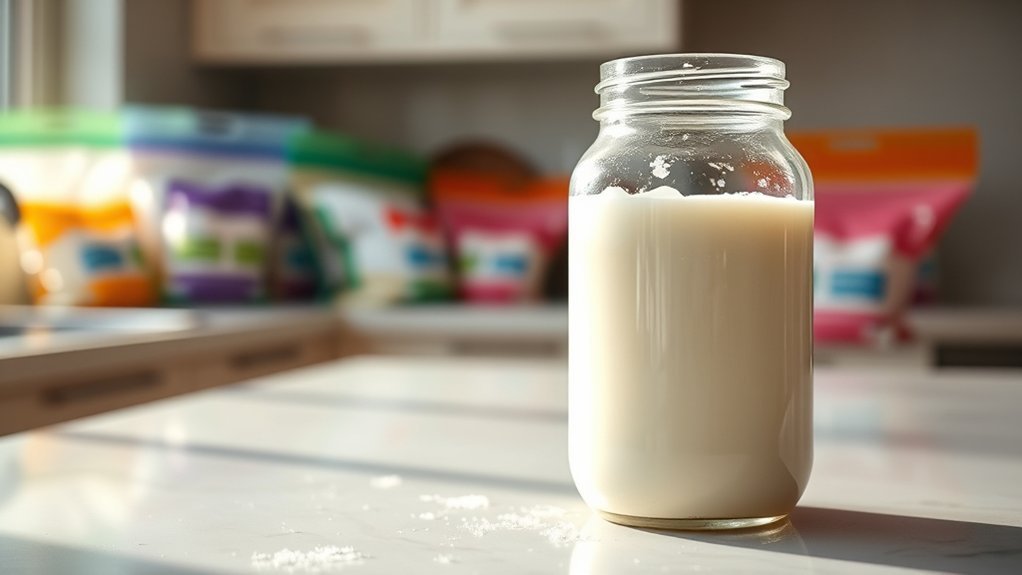Imagine opening your freezer to find neatly stored bags of breast milk, a lifeline of nutrition for your baby. Yet, you might be wrestling with doubts about its safety and quality. Is it really true that freezing destroys nutrients? Can you refreeze thawed milk? These questions are common and essential for any parent traversing the world of breastfeeding. Let’s explore the myths and uncover the facts behind freezing breast milk.
Common Myths About Freezing Breast Milk
When it comes to freezing breast milk, many parents encounter a range of misconceptions that can lead to confusion.
One common myth is that freezing destroys all nutrients in breast milk. In reality, freezing preserves most of the beneficial properties.
Freezing breast milk preserves most of its beneficial properties, contrary to the myth that it destroys nutrients.
You might also hear that you can’t refreeze thawed milk, but as long as it’s been thawed in the fridge and not left out, it’s safe to refreeze once.
Another misconception is that breast milk must be used within a few days after freezing; in fact, properly frozen milk can last for several months.
Understanding these myths can help you confidently manage your breast milk storage, ensuring your baby receives the best nutrition possible.
Proper Storage Guidelines for Breast Milk
Proper storage of breast milk is essential to guarantee your baby receives safe and nutritious feedings. Follow these guidelines to maintain ideal freshness:
| Storage Method | Timeframe |
|---|---|
| Room temperature (up to 77°F) | 4 hours |
| Refrigerator (at 32-39°F) | 4 days |
| Freezer (0°F or below) | 6 months |
| Deep freezer (-4°F) | 12 months |
| Thawed milk (in fridge) | 24 hours |
Always use clean containers and label them with the date. If you’re unsure about the milk’s quality, it’s better to err on the side of caution. Proper storage not only preserves nutrients but also protects your baby’s health.
Thawing Breast Milk: Do’s and Don’ts
After you’ve stored breast milk correctly, the next step is thawing it safely to confirm your baby gets the best nutrition.
Always thaw breast milk in the refrigerator or by placing the container under warm running water. This helps preserve the milk’s nutrients.
Thaw breast milk in the refrigerator or under warm running water to keep its nutrients intact.
Avoid using a microwave, as it can create hot spots that may burn your baby. Don’t refreeze thawed breast milk; it’s best to use it within 24 hours.
You can gently swirl the milk to mix, but don’t shake it vigorously, as this can break down beneficial components.
Always check the temperature before feeding. Following these do’s and don’ts confirms your baby receives safe and nutritious breast milk every time.
Safety Considerations for Frozen Breast Milk
Ensuring the safety of frozen breast milk is essential for your baby’s health and nutrition. Here are some important safety considerations to keep in mind:
- Label containers: Always label your containers with the date and time of expression.
- Use appropriate storage: Store milk in clean, BPA-free containers or breast milk storage bags specifically designed for freezing.
- Follow freezing guidelines: Freeze breast milk within 24 hours of expression to maintain its nutritional quality.
- Avoid temperature fluctuations: Keep your freezer at a consistent temperature of 0°F (-18°C) or lower.
Best Practices for Using Frozen Breast Milk
Using frozen breast milk effectively is crucial for maximizing its benefits for your baby.
Start by labeling each container with the date and time of pumping, guaranteeing you use the oldest milk first. When you’re ready to use it, thaw the milk in the refrigerator overnight or by placing the container in warm water—never microwave it, as this can destroy nutrients.
Label each container with the date and time, thaw breast milk in the fridge or warm water, and never microwave.
After thawing, use the milk within 24 hours and don’t refreeze it. Always check the milk’s smell and appearance before feeding. If your baby doesn’t finish a bottle, discard any leftovers.
Following these best practices guarantees your baby receives the full nutritional value of your frozen breast milk, promoting their health and well-being.
Frequently Asked Questions
Can I Refreeze Breast Milk Once It’s Thawed?
You shouldn’t refreeze breast milk once it’s thawed. Doing so can compromise its quality and safety. Instead, use thawed milk within 24 hours and store any unused portions in the fridge to maintain freshness.
How Long Can Breast Milk Stay Frozen?
Breast milk can stay frozen for up to six months in a standard freezer and up to twelve months in a deep freezer. Make sure you label containers with dates to keep track of freshness.
Does Freezing Affect the Nutritional Value of Breast Milk?
Oh sure, let’s just freeze your nutrients away! But seriously, freezing breast milk preserves most of its nutritional value. It might slightly reduce some vitamins, but overall, your baby’s getting a fantastic source of nourishment.
Can I Mix Fresh and Frozen Breast Milk Together?
Yes, you can mix fresh and frozen breast milk, but make certain the fresh milk is cooled first. Always use the oldest milk first to guarantee proper storage and maintain the milk’s nutritional quality.
What Containers Are Best for Freezing Breast Milk?
You should use BPA-free plastic bags specifically designed for breast milk storage, or glass containers with airtight seals. These options prevent leaks, preserve freshness, and protect nutrients, ensuring your milk stays safe for your baby.
Conclusion
To sum up, don’t let common myths about freezing breast milk deter you from providing the best nutrition for your baby. The truth is, when stored correctly, breast milk retains its essential nutrients and can be safely frozen for months. By understanding the facts, you empower yourself to make informed decisions about your milk storage. So go ahead and confidently freeze, thaw, and use your breast milk—your baby’s health is worth it!
